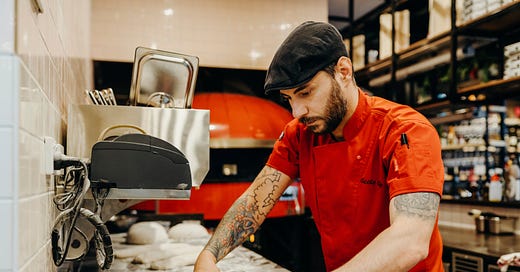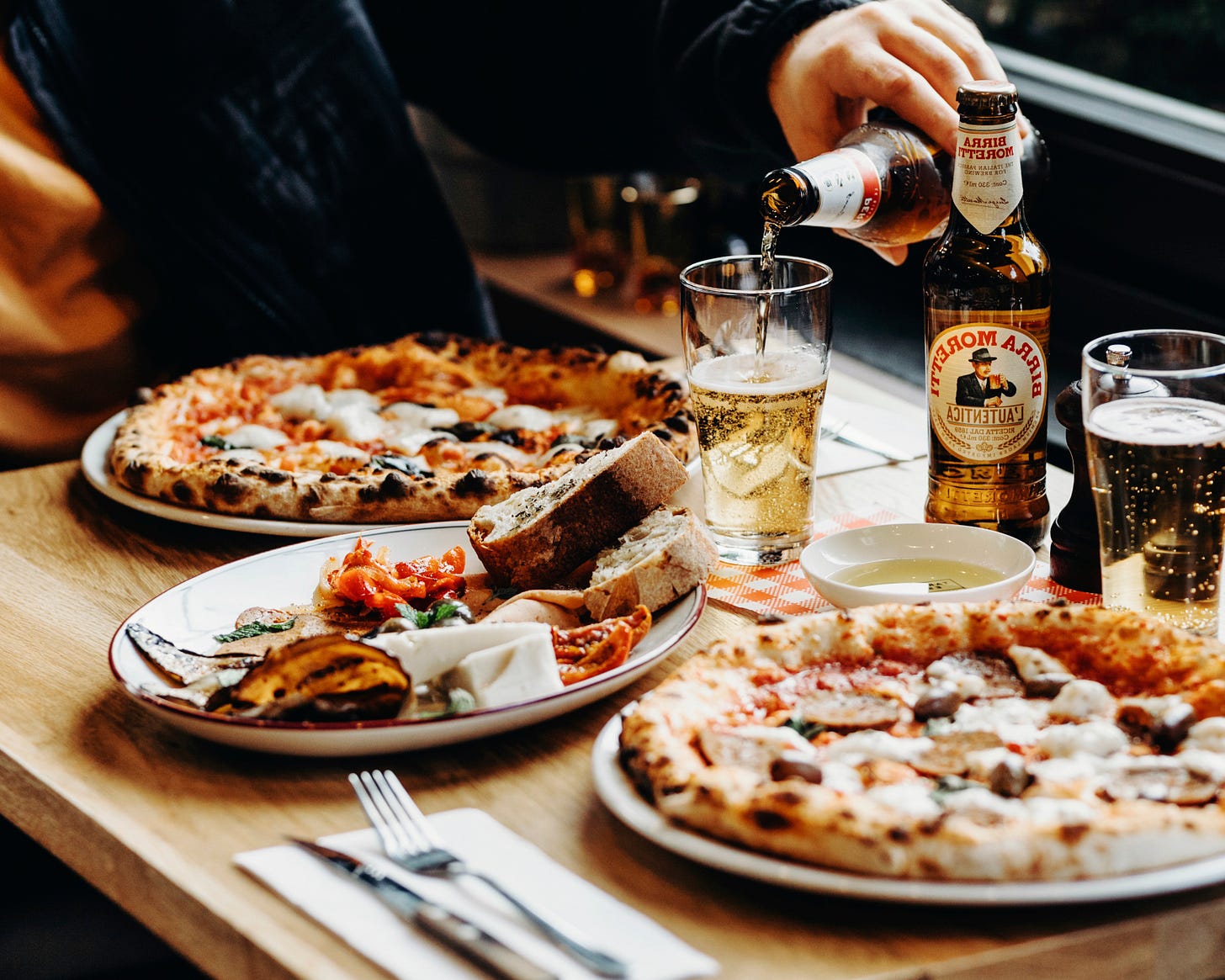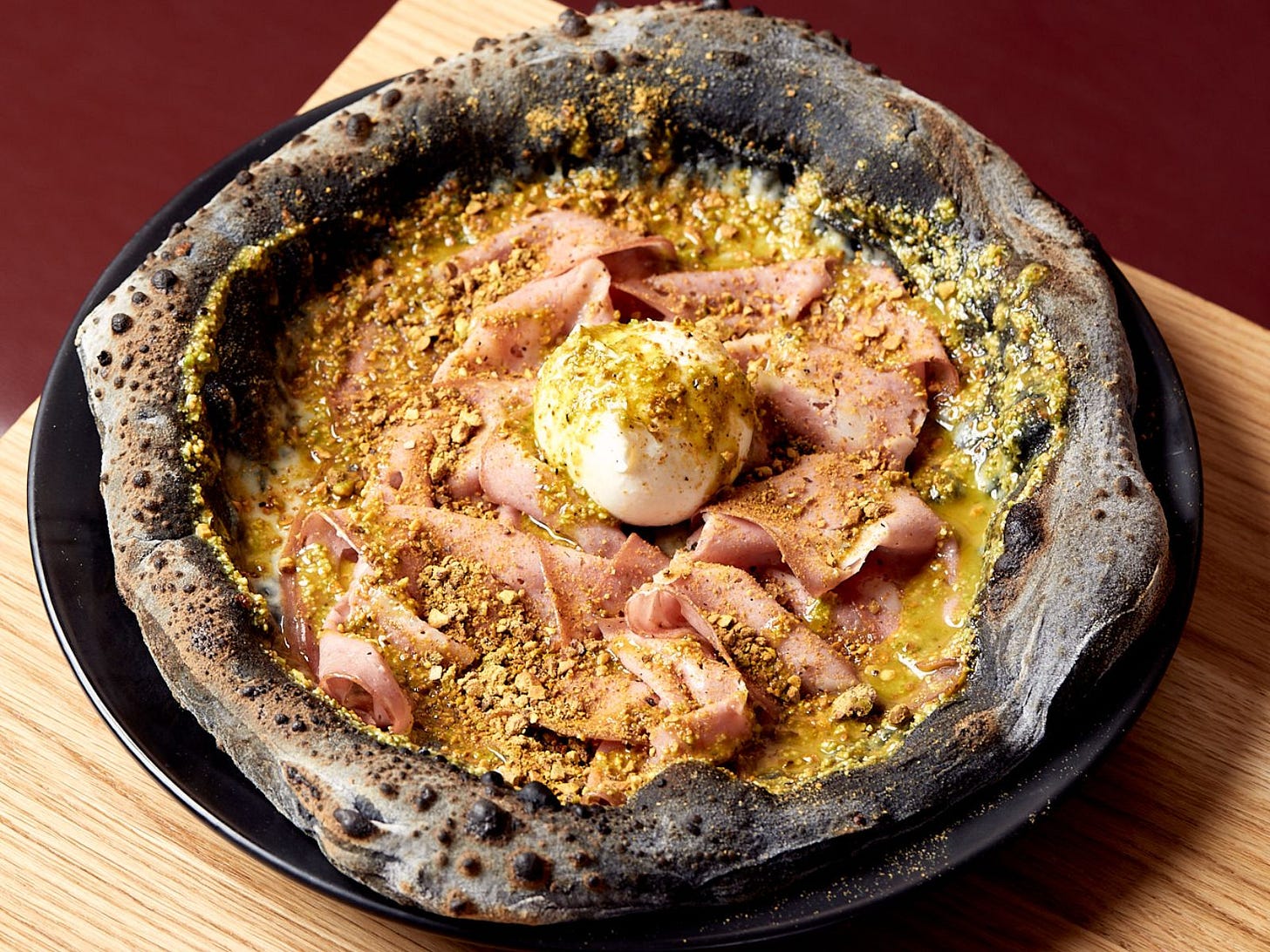The Bureau Q&A: Francesco "Ciccio" Crifo
The passionate pizzaiolo on provenance, padellino, and pineapple.
Ardent readers of the newsletter will have noticed a consistent theme: I am obsessed with pizza. On any and all occasions I am ready to wax lyrical about the merits of pizza, its many iterations, and the seemingly unending purveyors of the artform across our city. From the most refined Napoletana to the repulsive depths of Chicago deep dish, I’m open to the experience. Pizza is the food with the highest ceiling and the highest floor in terms of quality; even when it’s bad, it can be good.
Today, however, we are talking about very good pizza. At East Melbourne’s Roccella, head chef and pizzaiolo Francesco “Ciccio” Crifo channels his Sicilian heritage and passion for quality ingredients into some of Melbourne’s best pizza. Francesco has worked at some of the world's finest pizzerias, and has dedicated his life to the pursuit of perfection; listening to the passion he has for his craft only underlines my belief that pizza is a profoundly personal calling.
We spoke to “Ciccio” about provenance, padellino, and pineapple.
You were born in Catania, Sicily. What were some of your formative food experiences growing up?
My father was in hospitality and, therefore, was always against me getting into hospitality. I have fond memories of my grandparents cooking pizza at home and in our summer house on the farm, where we had a wood-fired oven. I was never interested in cooking when I left school at age 15 and was forced to find a job. I ended up in my friend‘s father's pizzeria. I commenced humbly with dishwashing, doing pizza deliveries, and unexpectedly fell in love with cooking.
What do you miss most about Sicily? Is there a Sicilian dish, style, or eating that you think is missing in Australia and could be a hit here?
In Sicily, especially in Catania, there is so much fantastic street food, from BBQ’d meats to catches of the day, and pizza served via a traditional hole in the wall. Whilst Melbourne has an incredibly strong food offering, honestly the best in Australia, certain products are barred from importation via freight for health reasons, so it is impossible to replicate certain dishes precisely. One thing I miss most is horse meat, which is considered a specialty in Catania and not very common in Australia.
Okay, let’s talk pizza. You practise a style of pizza called “Padellino”. Tell us about what makes this style of pizza unique?
Padellino is a thicker pizza, very light and fluffy in the middle and crunchy outside. This makes it easier to hold toppings, so we can be more creative and bring more artistic expression to the pizza. Whilst the ‘padellina’ technique requires more steps, time, and patience, we know the payoff is worth the result.
For example, the dough is steamed, par-baked, and baked in the oven. This elevates the taste of the grain used and complements the topping. The padellino can be served as a bite with fresh toppings like ricotta, anchovies, EVOO, and lemon zest or a more structured recipe like the one we create at the degustation in collaboration with chefs.
What, to you, makes good pizza?
Pizza is an art, it shouldn't have limitations. The pizza becomes a canvas for the chef’s personal expression. But it is also a science, and you need to have an in-depth knowledge of the ingredients you are using and the techniques to combine them together. For example, I was initially a sceptic when it came to pineapple pizza, but after weeks of tests, we came up with a recipe that couldn't fall short with Italian tastes. Essentially it took some ingredient selection and technique, then recipe development, a lot of tests and feedback, and of course a lot of personal reflection as I tried to express myself and my experience, as I do with all my dishes. I was amazed with how good it tastes, and now I always challenge Italians to try it and tell me that it is not good.
You mentioned the biggest taboo in the pizzaiolo world; pineapple. At Roccella, you’re embracing the Hawaiian with an elevated version, featuring smoked and charred pineapple, fior di latte, 24-month-aged prosciutto, stracciatella, and vincotto glaze. Were you nervous about introducing a pizza like this to your menu? How has it been received?
At first, I was against it, but then I took it as a challenge to promote the knowledge and the art of pizza and show everyone that with the right techniques, you can create amazing combinations and win over the taboos.
As I mentioned before, I always support creativity as this is an art, but you must have knowledge of ingredients and techniques. For example, you can't use tomato, mozzarella and pineapple together as the tomato and the pineapple don't go well together.
Ah, let me tell you about these contrasting flavours, okay? You see, tomato sauce has this rich, slightly acidic, and savoury taste, very much like what we love in Italy on our pizzas, you know? But pineapple comes in with its sweetness, its tanginess. Some folks might like this mix-up, but others, no, they say it's messing with the savoury beauty we expect from a real pizza.
And then, there's the moisture. Oh, Mamma Mia, pineapple is so juicy, yes? When you put it on the pizza and bake it, all this juice comes out, and mix with the tomato base…..no!
In Italy, pizza is a religion, and tradition is very closely guarded. Do you think authorities like the Campionato Mondiale della Pizza and the AVPN are too rigid in their criteria?
I have participated in and judged many pizza competitions. It’s a great opportunity for pizza chefs and colleagues to unite, exchange ideas, and create good memories. My only concern about these competitions is that today, there are too many with the title “ world pizza championship,” creating too many “world pizza champions.” The danger can be in the media reporting, as they may omit something like the style of the pizza, which leads to the distribution of wrong information. The AVPN, VPN, and many other associations in Italy preserve certain styles of pizza and protect this art. They must be strict, especially in preserving special styles of pizza like the original Napoletana. Even if today we also have modern versions, at least they protect that specific original style.
Unlike most pizzerias, you're very flexible with your bases; in fact, you serve four different ones. What are the key differences between the four?
We serve different dough, which also means different wheat/grain, different fermentation, and different styles, like the “classic romana tonda,” which is very thin and crunchy, or the gluten-free pizza, one of our strongest specialties. Those who are gluten intolerant often bite into our gluten free dough and ask in shock, “Is this really gluten free!?”
Like every head chef, the prospect of running a kitchen in the current restaurant climate is daunting. What are some of the key challenges you’re facing day to day at Roccella?
I think these days being an amazing Chef is not enough anymore if you also own a restaurant, you have to make important decisions that involve recruiting, managing people, accounting, finance, permits and much more, especially in big venues like Roccella where we are open 7 days breakfast, lunch, dinner and everything in between. I am lucky to have amazing business partners with many years of experience in running 50-plus food stores, and this makes it easier to learn more, but especially to split the responsibilities so I can focus more on my passion, which is creating and cooking.
You’re famous at Roccella for your pizza-making masterclasses. Without giving too much away, what are a few simple things we can do to improve?
It is unbelievable how our pizza class sells out, even these days when you have free access to millions of information on the web. But every time I finish a class, even the most experienced pizza amateur takes away at least 4-5 points he couldn't find online.
But it is really easy, we talk about putting together flour, water, yeast, salt and EVOO ... .but it
is the technique and my secret tips that make the difference! Here’s a secret tip. When you knead the dough, you are building a strong and elastic gluten, to do this by hand you need strong and big arms (just kidding, it's okay even small arms) and second, you need to stop kneading and mix again for 3-4 times with intervals of 5 minutes in between; this will help to absorb more water and to create a strong gluten structure.
If you could only choose one pizza to eat for the rest of your life, what would it be?
I love Margherita pizza with a lot of basil and even more with buffalo cheese.
Roccella
158 Clarendon St, East Melbourne VIC 3002
(03) 9416 1700








Great intel. This place is within walking distance and I’ve been curious about it so will def check it out now.